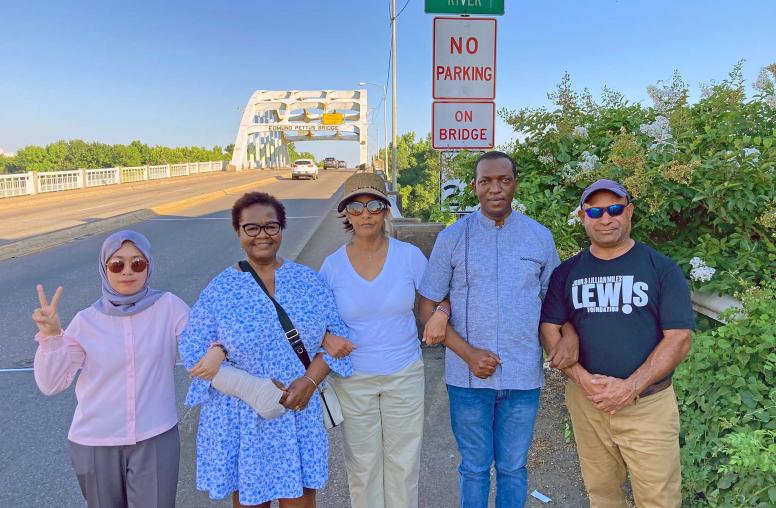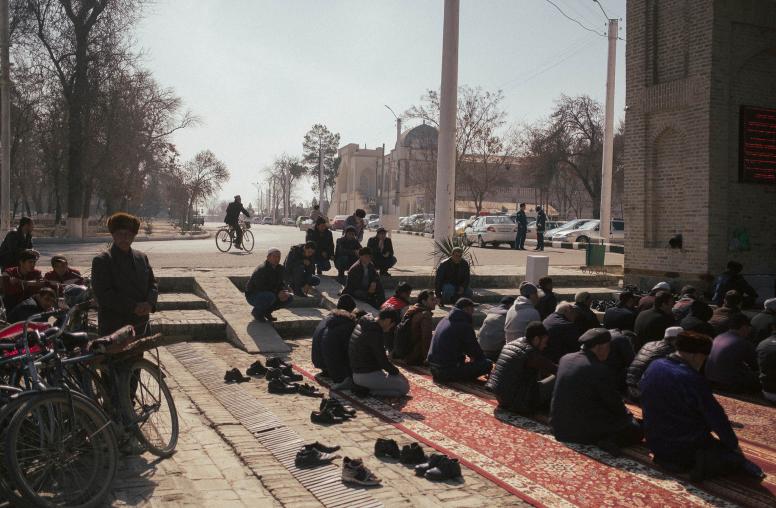At West Central High School in Hartford, South Dakota, the students in JoAnne Bohl’s history classes have learned about—and lived in—a world defined by war and violent conflict. Bohl, a part of USIP’s Peace Teacher program, wants students to think about conflict in new ways, and to cultivate their own potential to contribute to positive change around the world.

“We have a whole generation of students that has grown up in global conflict,” Bohl told local television reporter Simon Floss during a USIP visit to her class. “I think that learning conflict resolution and how to build peace are skills students can apply, whether it is to their history class or to current events. They can apply it in their personal lives, and they can certainly use it as they become citizens in the 21st Century.”
Helping to educate the American people about resolving international violent conflict and building peace is part of the U.S. Institute of Peace’s original mandate from Congress. This includes working with teachers at headquarters and across the country through a Public Education (PE) program. It can be difficult for these educators, however, to bring new ideas and curricula into the classroom.
To assist, we visit a range of communities each year, including those of our Peace Teachers, who spend a year working closely with USIP to incorporate into classrooms issues of international peace and conflict, and conflict management skills. For me, that included visits this school year to current Peace Teachers Bohl and Jennifer O’Boyle of Klahowya Secondary School in Silverdale, Washington. We not only support the work of these great educators, we also engage directly with young people who are curious about the world around them but might not yet see how to connect their own communities and USIP’s work across the globe.
What Is Conflict?
The connections start by thinking about what conflict actually means.
Teenagers in American high schools know a lot about conflict: their lives are full of it with parents, friends, online feuds and rival sports teams. They often associate the concept of conflict with something negative—bullying, fights, violence and war. PE works to promote the view that conflict is neutral. It becomes negative only when violence is used to resolve differences. When groups, communities and nations employ knowledge and skill to manage differences nonviolently, it is an essential, transformational force.
My visit to West Central offered a chance to probe the nuances of conflict with students by first looking at the ways people respond to conflict and why it is important to recognize the categories of response.
Through an interactive card game, we explored knowing your “conflict style”—its strengths, its weaknesses, when it might be most effective, and how it can be helpful in figuring out a strategy to handle a particular situation. Once the students had determined their dominant style—competitor, accommodator, compromiser, avoider or problem solver—they were presented with a different challenge: What does this look like when elevated to groups, or even countries? How do conflict styles manifest on the world stage?
Conflict Styles
With the classes starting to study World War II, Bohl divided her students into groups and asked each to look at one of the major parties on the eve of the war and during its opening period. What conflict style did the country have? Did it change? Why did it change?
Questions of “why” and “how” are integral to the resources that USIP provides educators seeking to bring peacebuilding skills into their classrooms. After participating in some of the activities themselves during a professional development session at Klahowya Secondary School, teachers said they appreciated that USIP materials can get students thinking, talking, and processing ideas and concepts in a new way. The resources help students develop critical thinking and encourage them to take ownership of their own learning, they said.
I find that while students come to class with their own understanding of conflict, they usually stumble on defining peace and understand it better as peacebuilding—something that is a process and takes long-term, hard work to make happen. At Klahowya, we spent significant time talking about what it means to work for peace and how peacebuilding is not something that only happens between heads of state at a negotiating table: It includes everyday people learning skills like mediation, dialogue and active listening.
I am thankful for the opportunity to have Allison Sturma, from the United States Institute of Peace, work with my classes today and some of our social studies staff this afternoon! #USIPPeaceTeacher #USIPPublicEducation pic.twitter.com/MjAcYfrvNk
— Jennifer O'Boyle (@Lit_Teach_Love) March 14, 2019
When asked to cite examples of peacebuilders, the students’ named internationally recognized figures such as Mahatma Gandhi, Martin Luther King Jr., or Malala Yousafzai. But peacebuilding is about more than household names and O’Boyle had talked with me about her students “yearning to see themselves as part of history and as part of building peace around them and in the world.” Connecting their high school lives to the global picture can be difficult.
Becoming a Peacebuilder
As a group we watched “Friendship Over Fear,” a short, USIP-produced video that explores the perspectives of two young men from different tribes in South Sudan. The two choose to look beyond the ethnic divisions fueling violence in their country and research new ways to build peace and help the reconciliation process. The video showed students that even in difficult conditions, young people can work to make a difference by focusing on the unique qualities they already have and that there are resources to help them gain new skills.
I wrapped up the conversation in each class by asking a simple question: How many of you view yourself as a peacebuilder? Over 12 classes at Klahowya, only a handful of students raised their hands at first. One young man, hesitant with his response, asked if mission trips to Central American to help build houses should count. I turned his question back to him—what did he think? The answer was yes. Eventually every hand went up as I added examples of what might constitute peacebuilding: Have you mediated a disagreement between friends? Held a leadership post? Raised awareness about something you cared about happening around the world? Volunteered?
The students came to see that there are many ways to work for peace in their communities and around the world. And that was the whole point. In upcoming trips to additional states, including Virginia, Tennessee and Alabama, our team will carry the same message, to support students and teachers in exploring what it means to resolve conflicts without violence and make peace possible.


